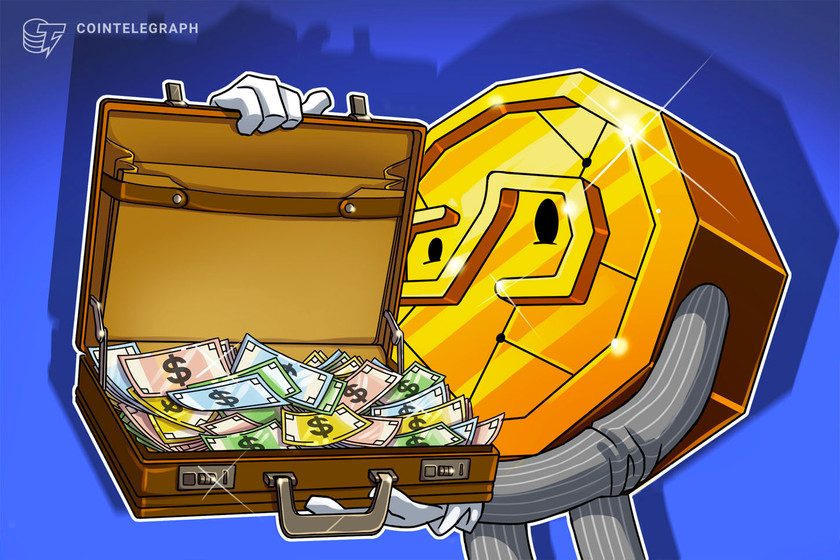
The widely-followed crypto analyst Michaël van de Poppe is updating his outlook on XRP (XRP) and VeChain (VET). The popular analyst tells his 643,300 Twitter followers that payments solution XRP could plummet by more than 22% if it fails to recover a key level quickly. “This one looks a bit odd, as we’ve seen a […]
The post Crypto Analyst Michaël van de Poppe Updates Outlook on XRP and One Top-50 Altcoin – Here Are His Price Targets appeared first on The Daily Hodl.

VeChain is a smart contract-compatible blockchain designed to enhance the supply chain and accelerate the mass adoption of blockchain technology.
The fundamental traits of blockchain technology, including decentralization, immutability, transparency and automation, have proven to be capable of several use cases for different businesses. However, due to the costs of creating and maintaining blockchain-powered applications, it can be difficult and expensive for enterprises to fully utilize its benefits.
With the adoption of distributed ledgers, many projects have put efforts to lower the barriers to entry. VeChain is one such blockchain platform built to improve widespread use of blockchain technology. One of the most significant issues facing supply chain organizations is a lack of transparency, which blockchain aims to resolve by enabling businesses to conduct transactions directly and without a third party. It also allows data sharing between stakeholders and supports increased integration of financial and logistical services.
This article will discuss what VeChain public blockchain is, the unique features of VeChain, how VeChain (VET) works, how to buy VeChain and how VeChain staking works.
A public blockchain called VeChainThor is intended for widespread use of blockchain technology by companies of all sizes by acting as the building block for a resilient and expandable enterprise blockchain ecosystem.
According to VeChain, Ethereum remains unsuited for running large-scale commercial decentralized applications (DApps) while being a significant technological milestone. It is because Ethereum does not have a robust governance framework to allow for quick and transparent protocol changes to address emerging issues or breakthroughs.
Also, an appropriate economic model is absent in the Ethereum blockchain, restricting businesses from operating their DApps at a controllable and predictable cost. In addition, given how volatile the price of Ether (ETH) is, companies may not forecast future ETH prices or the expense of maintaining an Ethereum-based decentralized application for a specific time. So, what makes VeChain unique?
The VeChainThor blockchain hopes to address the above issues using meta-transaction features, a proof-of-authority (PoA) consensus method, an on-chain governance mechanism and a unique two-token system.
For enterprise adoption, VeChain’s meta-transaction features, as discussed below, help make the development user-friendly:
PoA addresses the frequent issues businesses have with energy waste and ineffective upgrades. VeChain’s proof-of-authority is efficient because:
The community-elected Steering Committee, which oversees the VeChain ecosystem, makes decisions and ensures that they are carried out with the help of the on-chain governance mechanism (covering stages such as proposing, approving and executing). Other benefits of such a system include lower organizational and technical development uncertainty due to role-based voting.
The VeChain ecosystem comprises two tokens: VeChain Token (VET) and VeChainThor Energy (VTHO). The first token, VET, is used to create the second token VTHO, and to make payments or remittances to other VeChain users. With the VTHO token, transaction fees are settled, and the platform’s gas and smart contract development costs are covered.
The platform uses a PoA consensus algorithm that helps secure transactions on the blockchain network by using a network of 101 Authority Masternode operators. These operators carry out smart contract operations while upholding the VeChainThor governance rules.
Under the direction of the steering committee, users must complete rigorous Know Your Customer (KYC) checks and be able to contribute to the network’s growth, whether as a business, developer or other entity. Moreover, a unique two-token system (as discussed above) ensures that firms are protected from market speculation and excessive market volatility and can be more confident of their operating costs.
VeChain ToolChain is the key product offered by the VeChainThor blockchain platform that allows companies of all sizes to develop new services and products collaboratively. VeChain ToolChain provides platform-as-a-service (PaaS), software-as-a-service (SaaS), and blockchain-as-a-service (BaaS) to create new strategies for generating value for various stakeholders, promote transparency and offer insights into product life cycles.
For instance, VeChain’s low-code deployment PaaS allows customers to design process templates and use the in-built tools to avoid creating their own blockchain applications from scratch. In addition, its Food Safety Track & Trace SaaS offers the food and beverage industry a range of easily deployable traceability features, such as quality certificates, to communicate and reliably increase brand recognition.
Through BaaS, VeChain offers a restful API to standardized smart contract services. Two computer systems use the restful API, an application programming interface, to exchange information safely over the internet.
Furthermore, according to VeChain tokenomics, the circulating supply is decreased by burning 70% of all transaction fees, with the remaining 30% going to masternode operators. For node owners, VeChainThor offers a sustainable reward structure.
The former chief information officer of Louis Vuitton China, Sunny Lu, along with Changpeng Zhao (Chinese-Canadian founder of Binance) founded VeChain in 2015 as a subsidiary of Bitse, an organization that provides blockchain-powered solutions. The VEN token once operated on the Ethereum platform, but in 2018, VeChain switched to its own blockchain and rebranded itself as the VeChainThor (VET) blockchain.
Through data transparency, VeChain hopes to disrupt the supply chain industry. The business has collaborated with several companies, including Microsoft, PWC, BMW, Renault and Volkswagen, to take advantage of the unique features of the VeChainThor blockchain to enhance their business operations.
Related: How blockchain technology is used in supply chain management?
Depending upon your jurisdiction, choose a crypto exchange that supports VeChain (VET) cryptocurrency and buy a wallet to store your tokens. Alternatively, you can keep your tokens in the exchange wallet.
VeChain has also developed the Thor wallet specifically for its own cryptocurrency, which is compatible with both Android and iOS. However, VeChain tokens are incompatible with wallets like MetaMask since they are not based on the Ethereum blockchain. The final step is to purchase VET tokens for the amount you desire and transfer them to the wallet of your choice for safekeeping.
To buy VeChain (VET) on Binance, the key steps include the following:

Apart from buying VET, can you make passive income with VeChain? Typically, users must first buy other cryptocurrencies like Bitcoin (BTC) and then trade their BTC for VET after locating a wallet or exchange that supports VeChain staking. There aren’t any staking pools where one can combine VET investments to earn more VTHO, unlike other cryptocurrencies.
Related: How to earn passive crypto income with Bitcoin
Along with VeChain’s use cases in the supply chain, its nonfungible token (NFT) ecosystem is also thriving. For creating and trading VIP-181 tokens that are kept on the VeChain blockchain, there is a decentralized NFT marketplace called VeSea. The VeChain Foundation introduced the VIP-181 Standard, which enables fundamental functionality for tokens within smart contracts.
Users require a VeChain-compatible wallet in order to sell, purchase, and store NFTs on VeSea, which is compatible with VeChain Sync2 and VeChainThor Wallet. Additionally, because of the effectiveness of the underlying blockchain, VeSea has no gas expenses. However, users need to pay a 2.5% trading fee.
VeChain offers two NFT collections: VeKings and Paper Project. The 8,147 pieces of art are available in the VeKings NFT series, depicting the Vikings and Valkyries, symbols of the illustrious VeChain Empire. A total of 11,880 uniquely generated NFTs make up the interactive NFT Paper Project, which was developed and is being directed by Southern California-based artist Emmet Ahlstrom.
If anyone currently own an asset from one of these two NFT collections, VeSea will offer them a discount of up to 100%. World of V is another VeChain NFT marketplace compatible with the Sync2 wallet, which is free to use. In addition, by offering complete minting support, the platform welcomes new NFT projects through its launchpad and allows nonfungible token owners to stake their NFTs in the creator ecosystem.
VeChain aims to accelerate the mass adoption of blockchain technology by addressing issues, such as the high cost of maintaining an Ethereum-based DApp. Despite VeChain’s use cases in supply chain management and other industries, investment choice depends upon one’s financial objectives and risk-return profile.
That said, investing in a cryptocurrency in which you feel you need more confidence can be risky, and you may lose your hard-earned money. Therefore, determine your asset-allocation decisions based on your expectations for returns on your investment.
But, is the VeChain network secure? VeChain works with a number of security companies, including Hosho, Secureware, SlowMist, and HackenProof, to find potential vulnerabilities and proactively prevent cyber threats.
VeChain is a layer-1 smart contract platform that allows developers to create unique smart contracts and DApps on top of it. Its applications in logistics, supply chain management and other industries help businesses enhance their operations. However, from the investment perspective, one must always weigh the pros and cons before making portfolio allocations.
As the future is uncertain, the same goes for VeChain. That said, it cannot be predicted if VeChain will become the new Ethereum. Whatever the case, it will be exciting to see how VeChain will compete with its rivals and offer distinct solutions to achieve a competitive edge.

A leading crypto analyst says traders are staring down the barrel of a loaded altcoin market, ready to blow. Crypto trader Justin Bennett tells his 109,600 Twitter followers that the altcoin markets, crypto markets excluding Bitcoin (BTC), are preparing to explode. “The altcoin market cap chart is coiled for something big in October.” Bennett tags the leading […]
The post Analyst Says One Crypto Asset Could Surge in October, With Entire Altcoin Market Loaded Like a Spring appeared first on The Daily Hodl.
 The European Union (EU) is working on a project that involves blockchain architecture and the use of non-fungible tokens (NFTs) to fight counterfeiting and forgery. The project is the product of several meetings and blockchain hackathons organized by the European Union Intellectual Property Office and proposes to create digital twins of products to trace their […]
The European Union (EU) is working on a project that involves blockchain architecture and the use of non-fungible tokens (NFTs) to fight counterfeiting and forgery. The project is the product of several meetings and blockchain hackathons organized by the European Union Intellectual Property Office and proposes to create digital twins of products to trace their […]
Despite a handful of the top-80 coins gaining 12% or more over the past week, Tether's premium in Asia and futures markets activity show buyers lacking confidence.
Cryptocurrencies have failed to break the $1.1 trillion market capitalization resistance, which has been holding strong for the past 54 days. The two leading coins held back the market as Bitcoin (BTC) lost 2.5% and Ether (ETH) retraced 1% over the past seven days, but a handful of altcoins presented a robust rally.
Crypto markets’ aggregate capitalization declined 1% to $1.07 trillion between July 29 and Aug. 5. The market was negatively impacted by reports on Aug. 4 that the U.S. Securities and Exchange Commission (SEC) is investigating every U.S. crypto exchange after the regulator charged a former Coinbase employee with insider trading.

While the two leading cryptoassets were unable to print weekly gains, traders’ appetite for altcoins was not affected. Investors were positively impacted by the Coinbase exchange partnership with BlackRock, the world’s largest financial asset manager, responsible for $10 trillion worth of investments.
Coinbase Prime, the service offered to BlackRock’s clients, is an institutional trading solution that provides trading, custody, financing and staking on over 300 digital assets. Consequently, comparing the winners and losers among the top-80 coins provides skewed results, as 10 of those rallied 12% or more over the past seven days:

FLOW rallied 48% after Instagram announced support for the Flow blockchain via Dapper Wallet. The social network controlled by Meta (formerly Facebook) is expanding nonfungible token integration.
Filecoin (FIL) gained 38% following the v16 Skyr upgrade on Aug. 2, which hardened the protocol to avoid vulnerabilities.
VeChain (VET) gained 16.5% after some news sources incorrectly announced an Amazon Web Services (AWS) partnership. VeChain Foundation explained that the AWS reference was first cited in a May 9 case study.
The OKX Tether (USDT) premium is a good gauge of China-based crypto retail trader demand. It measures the difference between China-based peer-to-peer trades and the United States dollar.
Excessive buying demand tends to pressure the indicator above fair value at 100%, and during bearish markets, Tether’s market offer is flooded, causing a 4% or higher discount.

Currently, the Tether premium stands at 98.4%, its lowest level since June 10. While distant from retail panic selling, the indicator showed a modest deterioration over the past week.
However, weaker retail demand is not worrisome, as it partially reflects the total cryptocurrency capitalization being down 69% year-to-date.
Perpetual contracts, also known as inverse swaps, have an embedded rate usually charged every eight hours. Exchanges use this fee to avoid exchange risk imbalances.
A positive funding rate indicates that longs (buyers) demand more leverage. However, the opposite situation occurs when shorts (sellers) require additional leverage, causing the funding rate to turn negative.

As depicted above, the accumulated seven-day funding rate is either slightly positive or neutral for the largest cryptocurrencies by open interest. Such data indicates a balanced demand between leverage longs (buyers) and shorts (sellers).
Considering the absence of Tether demand in Asia and mixed perpetual contract premiums, there is a lack of confidence from traders as the total crypto capitalization struggles with the $1.1 trillion resistance. So, presently, bears seem to have the upper hand considering the uncertainties caused by the SEC pressing charges against a former Coinbase manager.
The views and opinions expressed here are solely those of the author and do not necessarily reflect the views of Cointelegraph. Every investment and trading move involves risk. You should conduct your own research when making a decision.

Zelis CTO Kali Durgampudi has called on health care providers to utilize blockchain tech to protect customer data and stave off attacks from cybercriminals.
Kali Durgampudi, the CTO of healthcare payments company Zelis, believes that the implementation of blockchain tech is vital for protecting patients' sensitive data from cybercriminals.
Speaking with Health IT News on July 20, Durgampudi noted that some of the biggest issues in healthcare are privacy and data security as the industry works to digitize its “archaic paper-based processes.”
“Blockchain technology has the potential to alleviate many of these concerns,” he said, as he highlighted the importance of utilizing a digital ledger that is “impenetrable” to protect sensitive patient and financial data amid the growing rate of cyberattacks across the globe.
“Since the information cannot be modified or copied, blockchain technology vastly reduces security risks, giving hospital and healthcare IT organizations a much stronger line of defense against cybercriminals.”
Durgampudi went on to note that blockchain tech can also play a key role in healthcare payments, as it can help provide greater transparency and efficiency over current payment models in healthcare. He said the many payers and providers were hesitant to share information via email as emails could go awry and there was no proof of delivery.
“Blockchain provides both payers and providers with complete visibility into the entire lifecycle of a claim, from the patient registering at the front desk to disputing a cost to sending an explanation of benefits,” he added.
One of the major companies that has worked on blockchain-based healthcare solutions is multinational tech giant IBM.
The blockchain arm of the company has rolled out several solutions for healthcare such as health credential verification, the 'Trust Your Supplier' service to find verified suppliers, and 'Blockchain Transparent Supply', which provides supply chain tracking on temperature-controlled pharmaceuticals.
In March 2021, Cointelegraph reported that IBM was working on a trial of a COVID-19 vaccination passport dubbed the “Excelsior Pass” in partnership with former New York Governor Andrew Cuomo. The passport was designed to be able to verify an individual's vaccination or test results by IBM's blockchain.
Related: Blockchain without crypto: Adoption of decentralized tech
Another key player in the blockchain-based healthcare space is enterprise blockchain VeChain. In June last year the project teamed up with Shanghai’s Renji Hospital to launch a blockchain-based In-Vitro fertilization (IVF) service application.
VeChain also partnered with The Republic of San Marino in July 2021 to launch an NFT-based vaccination passport that was said to be verifiable worldwide by scanning QR codes tied to the certificate.
David Jia, who is a blockchain investor and has a Ph.D. in Neuroscience from Oxford University, echoed similar sentiments to Durgampudi this week.
In a July 21 blog post on Medium, Jia emphasized that blockchain tech could significantly improve drug traceability and verification, along with the data management of clinical trials, patient info and claiming/billing.
“Accuracy in medical records over the long term as well as accessibility is essential, as it is necessary for an individual’s record to be able to be transferred between providers, insurance companies, and specialists with relative ease. If medical records are stored on a blockchain, they may be updated safely in almost real-time,” he wrote.

Closely followed crypto analyst Justin Bennett says that sizable downward moves are coming for two large-cap digital assets as Bitcoin trades below the $20,000 level. Bennett tells his 101,000 Twitter followers that leading memecoin Dogecoin (DOGE) has broken down from a rising wedge pattern, which indicates the resumption of the downtrend. According to the crypto […]
The post Steep Corrections Incoming for Dogecoin (DOGE) and VeChain (VET), According to Analyst Justin Bennett appeared first on The Daily Hodl.

The multi-year deal will see VeChain’s brand incorporated across multiple UFC marketing assets and reach an estimated 900 million households who watch the events worldwide.
Blockchain logistics firm the VeChain Foundation has signed a multi-year marketing partnership with the Ultimate Fighting Championship (UFC) worth nearly $100 million, becoming the UFC’s first-ever Layer 1 blockchain partner.
The UFC is the largest promoter and event organizer for Mixed Martial Arts (MMA) and VeChain’s marketing assets and brand will be integrated across the UFC in live events, in-arena promotion, social media and other areas.
The deal is reportedly worth almost $100 million over a minimum five-year partnership according to an anonymous source quoted by Sports Business Journal. The UFC’s Senior Vice President of Global Partnerships Paul Asencio said the UFC’s sponsorship revenues are up 30% from an already record-breaking 2021 as a result of the deal.
The partnership kicks off immediately and VeChain’s assets will start appearing this Saturday June 11 during a UFC event held in Singapore.
VeChain is a business focused layer 1 ecosystem with an emphasis on supply chain tracking. The partnership sees a big shift from Vechain’s frugal first quarter. A financial report released in May shows the VeChain Foundation only spent around $4 million in Q1 with less than $660,000 spent on marketing but it did amass a huge $1.2 billion “war chest.”
VeChain said the partnership is “one of the deepest integrations within premier UFC assets of any sponsor in UFC history,” with the UFC estimating VeChain’s brand will reach 900 million television households in 175 countries.
As part of the deal, VeChain will own UFC's official fighter rankings titleship now called the “UFC Rankings Powered by VeChain” along with a branded presence inside the fighting ring at all events.
VeChain will further be promoted in-venue on prominent digital displays and both companies will create content for the UFC’s social media and other digital platforms which the UFC estimates will reach 200 million people.
An annual “Brand Ambassador fund” will also offer paid opportunities to UFC athletes participating in marketing activities for VeChain.
Related: Blockchain, crypto set to take sports industry beyond NFT collectibles
The UFC has long partnered blockchain and crypto companies, one of the UFC’s largest partnerships is its $175 million deal with Crypto.com which saw the crypto exchange become the UFC’s “Cryptocurrency Platform Partner” with fighters receiving fan bonuses in Bitcoin (BTC) through the partnership.
Crypto.com also released the first authorized UFC non-fungible token (NFT) collection in November 2021 and the UFC has continued to release more licensed NFTs with NFT developer Dapper Labs.
In March 2021 the crypto-only casino and sports betting platform Stake become UFC’s “First Official Betting Partner” for its Asia and Latin America markets.

Widely followed crypto analyst Michaël van de Poppe says three popular altcoins are nearly ready to bounce back, starting with decentralized oracle network Chainlink (LINK). The crypto trader tells his 601,300 Twitter followers that while LINK’s price action has been worrisome, he’s predicting it finds support and ignites rallies in the near future. “Not the most […]
The post Chainlink (LINK), VeChain (VET) and One More Altcoin Nearing Potential Trend Reversals, Says Top Crypto Analyst appeared first on The Daily Hodl.

Crypto analyst Michaël van de Poppe says that Cardano (ADA), Chainlink (LINK) and three other altcoins offer some of the most attractive risk-reward ratios as the crypto markets continue to correct. In a new strategy session, Michaël van de Poppe tells his 165,000 YouTube subscribers that Cardano‘s area of interest is somewhere in the $0.70 […]
The post Cardano, Chainlink and Three Additional Altcoins Are the Top Crypto Assets To Accumulate This Month: Crypto Analyst appeared first on The Daily Hodl.